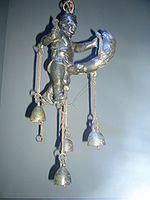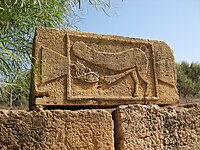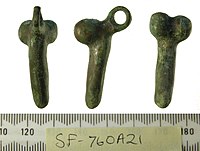Fascinus


Inancient Roman religionandmagic,thefascinusorfascinumwas the embodiment of the divinephallus.The word can refer to phalluseffigiesandamulets,and to the spells used to invoke his divine protection.[1]Plinycalled it amedicus invidiae,a "doctor" or remedy for envy (invidia,a "looking upon" ) or theevil eye.
Etymology
[edit]The English word "fascinate"ultimately derives from Latinfascinumand the related verbfascinare,"to use the power of thefascinus",that is," to practice magic "and hence" to enchant, bewitch ".Catullususes the verb at the end ofCarmen 7,ahendecasyllabicpoem addressing his lover Lesbia; he expresses his infinite desire for kisses that cannot be counted by voyeurs nor "fascinated" (put under a spell) by a malicious tongue; such bliss, as also inCarmen5, potentially attractsinvidia.[2]
Fescennine Verses,the satiric and often lewd songs or chants performed on various social occasions, may have been so-named from thefascinum;ancient sources propose this etymology along with an alternative origin fromFescennia,a small town inEtruria.[3]
Public religion
[edit]
TheVestal Virginstended the cult of thefascinuspopuli Romani,the sacred image of the phallus that was one of the tokens of the safety of the state(sacra Romana).It was thus associated with thePalladium.[4]Roman myths,such as the begetting ofServius Tullius,suggest that this phallus was an embodiment of a masculine generative power located within the hearth, regarded as sacred.[5]When a general celebrated atriumph,the Vestals hung an effigy of thefascinuson the underside of hischariotto protect him frominvidia.[6]
Augustine,whose primary source on Roman religion was the lost theological works ofMarcus Terentius Varro,notes that a phallic image was carried in procession annually at the festival ofFather Liber,the Roman godidentified withDionysus or Bacchus,for the purpose of protecting the fields fromfascinatio,magic compulsion:[7]
Varro says that certain rites of Liber were celebrated in Italy which were of such unrestrained wickedness that the shameful parts of the male were worshipped at crossroads in his honour.… For, during the days of thefestival of Liber,this obscene member, placed on a little trolley, was first exhibited with great honour at the crossroads in the countryside, and then conveyed into the city itself.… In this way, it seems, the god Liber was to be propitiated, in order to secure the growth of seeds and to repel enchantment(fascinatio)from the fields.[8]
As a divinized phallus, Fascinus shared attributes withMutunus Tutunus,whose shrine was supposed to date from thefounding of the city,and the imported Greek godPriapus.[9]
As a magic symbol
[edit]Phallic charms, often winged, were ubiquitous in Roman culture, appearing as objects of jewellery such as pendants and finger rings, relief carvings, lamps, and wind chimes (tintinnabula).[10][11][12]Fascinuswas thought particularly to ward off evil from children, mainly boys, and from conquering generals (see n. 6). The protective function of the phallus is usually related to the virile and regenerative powers of an erect phallus, though in most cases the emotion, shame, or laughter created by obscenity is the power that diverts the evil eye.[13]
There are very few Roman images of people wearing a phallic charm.[13]Varro notes the custom of hanging a phallic charm on a baby's neck,[a]and examples have been found of phallus-bearing rings too small to be worn except by children.[14]A 2017experimental archaeologyproject suggested that some types of phallic pendant were designed to remain pointing outwards, in the direction of travel of the wearer, in order to face towards any potential danger or bad luck and nullify it before it could affect the wearer.[15]Other symbols may have been interchangeable with the phallus, such as the club ofHercules.[13]
The victory of the phallus over the power of the evil eye may be represented by the phallus ejaculating towards a disembodied eye. This motif is shown in several examples of Roman art.[16]For example, the motif is known from multiplerelief sculpturesfromLeptis Magnain present-dayLibya,[11]as well as several instances onHadrian's Wall.[17]A 1st-century BCterracottafigurine shows "two little phallus-men sawing an eyeball in half".[10][11]
The "fist and phallus" amulet was prevalent amongst soldiers. These are phallic pendants with a representation of a (usually) clenched fist at the bottom of the shaft, facing away from theglans.Several examples show the fist making themanus ficaor "fig sign",a symbol of good luck.[14][18]The largest known collection comes fromCamulodunum.[19]Some examples of the fist-and-phallus amulets incorporatevulvarimagery as well as an extraapotropaicdevice.[20]
-
AtintinnabulumfromHerculaneum(Italy), with the phallus as a beast which the human male engages in combat.
-
Bas-relief of a legged phallus ejaculating into anevil eyeon which a scorpion sits, fromLeptis Magna(Libya).
-
A simple phallic relief fromEboracum(York, UK).
-
A phallic pendant from Kent (UK).
-
A simple phallic pendant from Suffolk (UK).
See also
[edit]Notes
[edit]- ^Varro,On the Latin language,VII.97
References
[edit]- ^Theneuterformfascinumis used most often for objects or magic charms, masculinefascinusfor the god.
- ^David Wray,Catullus and the Poetics of Roman Manhood(Cambridge University Press, 2001), p. 152.
- ^Gian Biagio Conte,Latin Literature: A History(Johns Hopkins University Press, 1987, 1994), p. 23.
- ^R. Joy Littlewood,ACommentaryonOvid:FastiBook 6(Oxford University Press, 2006), p. 73;T.P. Wiseman,Remus: A Roman Myth(Cambridge University Press, 1995), p. 61online.
- ^Joseph Rykwert,The Idea of a Town: The Anthropology of Urban Form in Rome, Italy, and the Ancient World(MIT Press, 1988), pp. 101 and 159online.
- ^Pliny,Natural History28.4.7 (28.39).
- ^Augustine of Hippo,De civitate Dei7.21; Williams,Roman Homosexuality,p. 92.
- ^English translation by R.W. Dyson,Augustine: The City of God against the Pagans(Cambridge University Press, 1998, 2002), p. 292online.
- ^Arnobius,Adversus nationes4.7, explicitly connects Tutunus to thefascinus;seeRobert E.A. Palmer,"Mutinus Titinus: A Study in Etrusco-Roman Religion and Topography," inRoman Religion and Roman Empire: Five Essays(University of Pennsylvania Press, 1974), pp. 187–206.
- ^abWilliams, C. A. (1999).Roman Homosexuality: Ideologies of Masculinity in Classical Antiquity.City University of New York. p. 92.
- ^abcJohns, C.(1982).Sex or Symbol? Erotic Images of Greece and Rome.London: British Museum Press.
- ^Parker, A. (2018). "The Bells! The Bells! Approachingtintinnabulain Roman Britain and Beyond ". In Parker, A.; Mckie, S. (eds.).Material Approaches to Roman Magic: Occult Objects and Supernatural Substances.TRACThemes in Roman Archaeology 2. Oxford: Oxbow. pp. 57–68.
- ^abcDasen, V. (2015). "Pobaskania: Amulets and Magic in Antiquity". In Boschung, D.; Bremmer, J. N. (eds.).The Materiality of Magic.Morphomata 20. pp. 177–204.
- ^abMartin Henig,Religion in Roman Britain(London: BT Batsford LTD, 1984), pp. 185–186online,with image of example.
- ^Whitmore, A. (2017). "Fascinatingfascina:apotropaic magic and how to wear a penis ". In Cifarelli, M.; Gawlinkski, L. (eds.).What shall I say of clothes? Theoretical and Methodological Approaches to the Study of Dress in Antiquity.Boston, MA:American Institute of Archaeology.pp. 47–65.
- ^Daniel Ogden,Magic, Witchcraft, and Ghosts in the Greek and Roman Worlds: A Sourcebook(Oxford University Press, 2002), p. 225online.
- ^Parker, A. (2017). "Protecting the Troops? Phallic Carvings in the North of Roman Britain". In Parker, A (ed.).Ad Vallum:Papers on the Roman Army and Frontiers in celebration of DrBrian Dobson.BAR British Series 631. Oxford: British Archaeological Report. pp. 117–130.
- ^"PAS Record: LIN-2BE126".Portable Antiquities Scheme.Retrieved13 July2018.
- ^Crummy, N. (1983).Colchester Archaeological Report 2: The Roman Small finds from excavations in Colchester 1971-9.Colchester: Colchester Archaeological Trust.
- ^Parker, A. (2015). "The Fist-and-Phallus Pendants from Roman Catterick".Britannia.46:135–149.doi:10.1017/S0068113X15000161.S2CID163628404.





